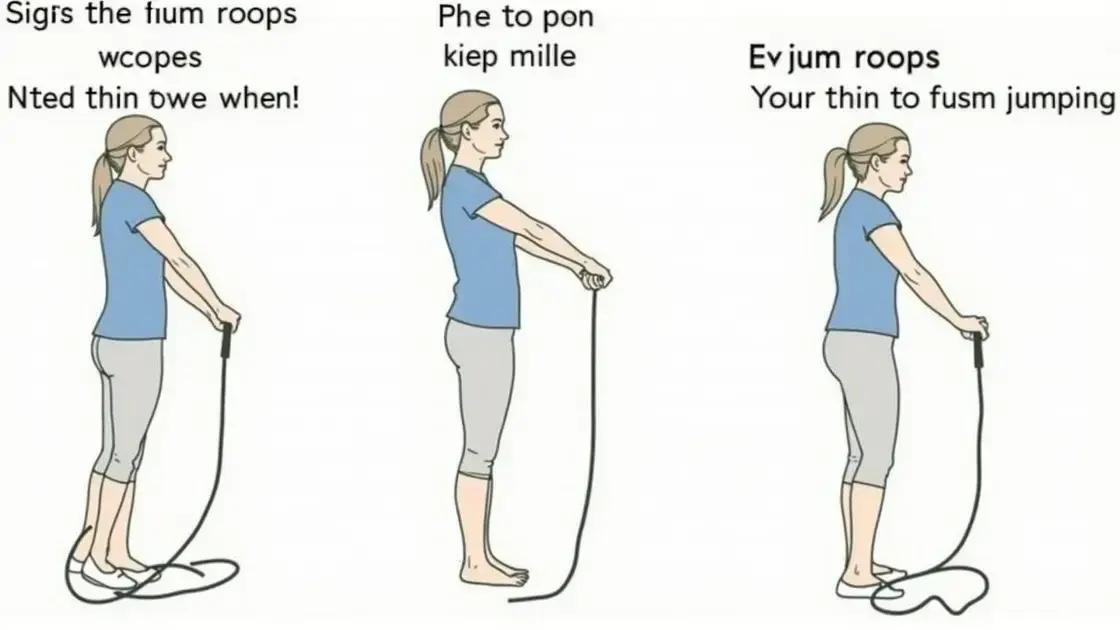Jump rope training is a highly effective workout for improving cardiovascular health, enhancing coordination, and promoting weight loss. By incorporating proper techniques and setting realistic goals, individuals of all fitness levels can enjoy the benefits of jump rope workouts. Consistent practice, along with mixing exercises and tracking progress, will help maintain motivation and achieve desired results.
Jump rope training is an exhilarating way to boost cardiovascular health and elevate your fitness game. Incorporating this simple yet effective exercise into your workout routine can lead to significant improvements in endurance, coordination, and overall heart health. In this article, we’ll delve into the benefits of jump rope training, share effective techniques, and provide tips on how to seamlessly integrate jump rope into your existing fitness plan.
Understanding Jump Rope Training Benefits

Jump rope training has countless benefits for enhancing your cardiovascular health. It is a fun and effective workout that can be done almost anywhere, making it accessible for everyone.
Improves Cardiovascular Fitness
Regularly practicing jump rope can significantly improve your heart and lung health. As you jump, your heart must pump more blood, which helps strengthen your heart muscles and increases lung capacity.
Boosts Coordination and Agility
Jumping rope requires coordination of your hands, feet, and eyes. This constant engagement strengthens your athleticism, helping you to move more gracefully and faster in other physical activities.
Burns Calories Efficiently
Jump rope workouts can burn a substantial number of calories in a short amount of time. For instance, just 15 minutes of jump rope can burn more calories than running for the same duration, making it an excellent choice for weight loss.
Enhances Mood and Reduces Stress
Like other forms of exercise, jump rope training releases endorphins that uplift mood and reduce stress. This can lead to improved mental health and overall well-being.
Strengthens Muscles
Jumping rope works multiple muscle groups, including your arms, legs, and core. Over time, this can lead to improved muscle tone and strength without the need for heavy equipment.
Effective Jump Rope Techniques

To get the most out of your jump rope training, it is important to use effective jump rope techniques. Here are some tips to help you master your technique.
Proper Grip
Hold the handles of the jump rope lightly but firmly. Your hands should be about waist height, and your elbows should stay close to your body. This will help you maintain better control.
Use the Right Posture
Stand tall with your back straight and your head up. Your knees should be slightly bent, and your feet should be shoulder-width apart. Good posture enhances your performance and prevents injuries.
Jumping Technique
When you jump, use your ankles and keep your jumps low, about one to two inches off the ground. This reduces impact on your joints and helps maintain rhythm. Try to land lightly on the balls of your feet.
Rope Speed and Timing
Use your wrists to spin the rope, not your arms. Quick wrist movements can make the rope turn faster. Additionally, focus on the timing of your jumps to synchronize with the rope’s movement.
Start Slow and Increase Speed
Begin with slower jumps to master the technique. Once you feel comfortable, gradually increase your speed. This practice can enhance your endurance and overall effectiveness.
Incorporating Jump Rope into Your Routine

Incorporating jump rope into your routine is easy and beneficial for cardiovascular health. Here are some ways to do it effectively.
Set Clear Goals
Before adding jump rope to your workouts, define what you want to achieve. Whether it’s improving endurance, losing weight, or enhancing coordination, having goals will help you stay focused.
Start Small
If you are new to jump roping, begin with short sessions. For example, try jumping for just 5 to 10 minutes at a time. Gradually increase your duration as you gain confidence and improve your skill.
Mix It Up
Integrate jump rope into different types of workouts. You can use it as a warm-up before strength training, a cool-down exercise, or as a high-intensity interval in your cardio routine. This will keep your workouts fresh and exciting.
Create a Schedule
Consistency is key for any fitness routine. Schedule jump rope sessions a few times a week. You might aim for two to three days dedicated to jump rope training to see significant improvements.
Track Your Progress
Keep a log of your jump rope sessions, noting the duration and any new techniques you are trying. Tracking your progress can motivate you and help you identify what works best for you.
Tips for Consistent Jump Rope Workouts

Staying consistent with your jump rope workouts can significantly enhance your cardiovascular health. Here are some tips to keep you on track.
Set Realistic Goals
Set achievable goals for your jump rope sessions. Start with small milestones, like jumping for five minutes without stopping, then gradually increase your targets.
Create a Routine
Designate specific days and times for your jump rope workouts. Consistency is crucial, so treat these sessions as important appointments on your calendar.
Use the Right Equipment
Choose a high-quality jump rope that feels comfortable in your hands. This can help you enjoy your workouts more and make it easier to stick to your routine.
Stay Motivated
Find ways to keep your motivation high. Consider joining jump rope groups online, watching tutorial videos, or following social media accounts that inspire you to jump.
Mix Up Your Workouts
Prevent boredom by mixing various jump rope exercises. You can try different techniques, increase speed, or incorporate music to keep your workouts fresh and exciting.
Jump Rope Training for Enhanced Cardiovascular Health
Incorporating jump rope training into your fitness routine can lead to significant improvements in cardiovascular health, coordination, and overall fitness levels. By understanding the benefits, utilizing effective techniques, and maintaining a consistent schedule, you can enjoy the numerous rewards that come from this engaging and versatile workout.
Whether you’re just starting or looking to enhance your existing routine, remember to set realistic goals, track your progress, and mix up your workouts to keep things exciting. With determination and the right approach, jump rope training can transform your health and fitness journey.
Embrace the jump rope as a valuable tool in your fitness arsenal and take steps towards a healthier lifestyle today!
FAQ – Frequently Asked Questions about Jump Rope Training
What are the primary benefits of jump rope training?
Jump rope training improves cardiovascular fitness, boosts coordination, burns calories efficiently, and enhances mood while reducing stress.
How often should I practice jump rope to see results?
Aim for two to three sessions per week, gradually increasing the duration and intensity as you become more comfortable.
What techniques should I focus on as a beginner?
Focus on proper grip, maintaining good posture, and developing a consistent jumping technique to build your skills effectively.
Can I mix jump rope with other workouts?
Absolutely! You can use jump rope as a warm-up, a high-intensity interval, or a cool-down exercise to add variety to your routine.
How can I stay motivated to keep jumping rope?
Set realistic goals, track your progress, join online communities, and mix up your routines to keep things exciting.
Is jump rope training suitable for all fitness levels?
Yes! Jump rope training can be adapted for all fitness levels, from beginners to advanced athletes. Start at your own pace and progress as you gain strength and endurance.












